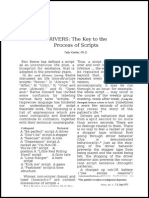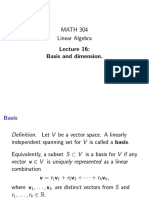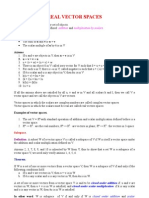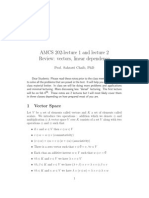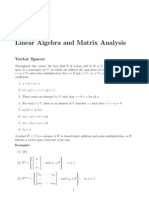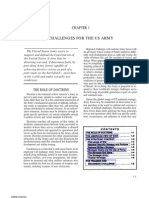MATH 304 Linear Algebra Basis and Dimension
Uploaded by
sparkshockMATH 304 Linear Algebra Basis and Dimension
Uploaded by
sparkshockMATH 304
Linear Algebra
Lecture 16:
Basis and dimension.
Basis
Denition. Let V be a vector space. A linearly
independent spanning set for V is called a basis.
Equivalently, a subset S V is a basis for V if any
vector v V is uniquely represented as a linear
combination
v = r
1
v
1
+ r
2
v
2
+ + r
k
v
k
,
where v
1
, . . . , v
k
are distinct vectors from S and
r
1
, . . . , r
k
R.
Examples. Standard basis for R
n
:
e
1
= (1, 0, 0, . . . , 0, 0), e
2
= (0, 1, 0, . . . , 0, 0),. . . ,
e
n
= (0, 0, 0, . . . , 0, 1).
Matrices
_
1 0
0 0
_
,
_
0 1
0 0
_
,
_
0 0
1 0
_
,
_
0 0
0 1
_
form a basis for M
2,2
(R).
Polynomials 1, x, x
2
, . . . , x
n1
form a basis for
P
n
= {a
0
+ a
1
x + + a
n1
x
n1
: a
i
R}.
The innite set {1, x, x
2
, . . . , x
n
, . . . } is a basis
for P, the space of all polynomials.
Bases for R
n
Theorem Every basis for the vector space R
n
consists of n vectors.
Theorem For any vectors v
1
, v
2
, . . . , v
n
R
n
the
following conditions are equivalent:
(i) {v
1
, v
2
, . . . , v
n
} is a basis for R
n
;
(ii) {v
1
, v
2
, . . . , v
n
} is a spanning set for R
n
;
(iii) {v
1
, v
2
, . . . , v
n
} is a linearly independent set.
Dimension
Theorem Any vector space V has a basis. All
bases for V are of the same cardinality.
Denition. The dimension of a vector space V,
denoted dimV, is the cardinality of its bases.
Remark. By denition, two sets are of the same cardinality if
there exists a one-to-one correspondence between their elements.
For a nite set, the cardinality is the number of its elements.
For an innite set, the cardinality is a more sophisticated
notion. For example, Z and R are innite sets of dierent
cardinalities while Z and Q are innite sets of the same
cardinality.
Examples. dimR
n
= n
M
2,2
(R): the space of 22 matrices
dimM
2,2
(R) = 4
M
m,n
(R): the space of mn matrices
dimM
m,n
(R) = mn
P
n
: polynomials of degree less than n
dimP
n
= n
P: the space of all polynomials
dimP =
{0}: the trivial vector space
dim{0} = 0
Problem. Find the dimension of the plane
x + 2z = 0 in R
3
.
The general solution of the equation x + 2z = 0 is
_
_
_
x = 2s
y = t
z = s
(t, s R)
That is, (x, y, z) = (2s, t, s) = t(0, 1, 0) + s(2, 0, 1).
Hence the plane is the span of vectors v
1
= (0, 1, 0)
and v
2
= (2, 0, 1). These vectors are linearly
independent as they are not parallel.
Thus {v
1
, v
2
} is a basis so that the dimension of
the plane is 2.
How to nd a basis?
Theorem Let S be a subset of a vector space V.
Then the following conditions are equivalent:
(i) S is a linearly independent spanning set for V,
i.e., a basis;
(ii) S is a minimal spanning set for V;
(iii) S is a maximal linearly independent subset of V.
Minimal spanning set means remove any element from this
set, and it is no longer a spanning set.
Maximal linearly independent subset means add any
element of V to this set, and it will become linearly
dependent.
Theorem Let V be a vector space. Then
(i) any spanning set for V can be reduced to a
minimal spanning set;
(ii) any linearly independent subset of V can be
extended to a maximal linearly independent set.
Equivalently, any spanning set contains a basis,
while any linearly independent set is contained in a
basis.
Corollary A vector space is nite-dimensional if
and only if it is spanned by a nite set.
How to nd a basis?
Approach 1. Get a spanning set for the vector
space, then reduce this set to a basis.
Proposition Let v
0
, v
1
, . . . , v
k
be a spanning set
for a vector space V. If v
0
is a linear combination
of vectors v
1
, . . . , v
k
then v
1
, . . . , v
k
is also a
spanning set for V.
Indeed, if v
0
= r
1
v
1
+ + r
k
v
k
, then
t
0
v
0
+ t
1
v
1
+ + t
k
v
k
=
= (t
0
r
1
+ t
1
)v
1
+ + (t
0
r
k
+ t
k
)v
k
.
How to nd a basis?
Approach 2. Build a maximal linearly independent
set adding one vector at a time.
If the vector space V is trivial, it has the empty basis.
If V = {0}, pick any vector v
1
= 0.
If v
1
spans V, it is a basis. Otherwise pick any
vector v
2
V that is not in the span of v
1
.
If v
1
and v
2
span V, they constitute a basis.
Otherwise pick any vector v
3
V that is not in the
span of v
1
and v
2
.
And so on. . .
Problem. Find a basis for the vector space V
spanned by vectors w
1
= (1, 1, 0), w
2
= (0, 1, 1),
w
3
= (2, 3, 1), and w
4
= (1, 1, 1).
To pare this spanning set, we need to nd a relation
of the form r
1
w
1
+r
2
w
2
+r
3
w
3
+r
4
w
4
= 0, where
r
i
R are not all equal to zero. Equivalently,
_
_
1 0 2 1
1 1 3 1
0 1 1 1
_
_
_
_
_
_
r
1
r
2
r
3
r
4
_
_
_
_
=
_
_
0
0
0
_
_
.
To solve this system of linear equations for
r
1
, r
2
, r
3
, r
4
, we apply row reduction.
_
_
1 0 2 1
1 1 3 1
0 1 1 1
_
_
_
_
1 0 2 1
0 1 1 0
0 1 1 1
_
_
_
_
1 0 2 1
0 1 1 0
0 0 0 1
_
_
_
_
1 0 2 0
0 1 1 0
0 0 0 1
_
_
(reduced row echelon form)
_
_
_
r
1
+ 2r
3
= 0
r
2
+ r
3
= 0
r
4
= 0
_
_
_
r
1
= 2r
3
r
2
= r
3
r
4
= 0
General solution: (r
1
, r
2
, r
3
, r
4
)=(2t, t, t, 0), t R.
Particular solution: (r
1
, r
2
, r
3
, r
4
) = (2, 1, 1, 0).
Problem. Find a basis for the vector space V
spanned by vectors w
1
= (1, 1, 0), w
2
= (0, 1, 1),
w
3
= (2, 3, 1), and w
4
= (1, 1, 1).
We have obtained that 2w
1
+ w
2
w
3
= 0.
Hence any of vectors w
1
, w
2
, w
3
can be dropped.
For instance, V = Span(w
1
, w
2
, w
4
).
Let us check whether vectors w
1
, w
2
, w
4
are
linearly independent:
1 0 1
1 1 1
0 1 1
1 0 1
1 1 0
0 1 0
1 1
0 1
= 1 = 0.
They are!!! It follows that V = R
3
and
{w
1
, w
2
, w
4
} is a basis for V.
Vectors v
1
= (0, 1, 0) and v
2
= (2, 0, 1) are
linearly independent.
Problem. Extend the set {v
1
, v
2
} to a basis for R
3
.
Our task is to nd a vector v
3
that is not a linear
combination of v
1
and v
2
.
Then {v
1
, v
2
, v
3
} will be a basis for R
3
.
Hint 1. v
1
and v
2
span the plane x + 2z = 0.
The vector v
3
= (1, 1, 1) does not lie in the plane
x + 2z = 0, hence it is not a linear combination of
v
1
and v
2
. Thus {v
1
, v
2
, v
3
} is a basis for R
3
.
Vectors v
1
= (0, 1, 0) and v
2
= (2, 0, 1) are
linearly independent.
Problem. Extend the set {v
1
, v
2
} to a basis for R
3
.
Our task is to nd a vector v
3
that is not a linear
combination of v
1
and v
2
.
Hint 2. At least one of vectors e
1
= (1, 0, 0),
e
2
= (0, 1, 0), and e
3
= (0, 0, 1) is a desired one.
Let us check that {v
1
, v
2
, e
1
} and {v
1
, v
2
, e
3
} are
two bases for R
3
:
0 2 1
1 0 0
0 1 0
= 1 = 0,
0 2 0
1 0 0
0 1 1
= 2 = 0.
You might also like
- Property and Social Relations in Melanesian Anthropology (J. Carrier)No ratings yetProperty and Social Relations in Melanesian Anthropology (J. Carrier)21 pages
- Linear Algebra McGill Assignment + Solutions100% (1)Linear Algebra McGill Assignment + Solutions9 pages
- L7 - Linear Algebra - Linear CombinationNo ratings yetL7 - Linear Algebra - Linear Combination11 pages
- Span, Linear Independence, and Dimension: Math 240 - Calculus IIINo ratings yetSpan, Linear Independence, and Dimension: Math 240 - Calculus III17 pages
- Mathematics Ii: MATH F112 Department of Mathematics BITS Pilani K K Birla Goa CampusNo ratings yetMathematics Ii: MATH F112 Department of Mathematics BITS Pilani K K Birla Goa Campus27 pages
- Modul 5-B_GVS Linear Dependence-editedAruni EnglishNo ratings yetModul 5-B_GVS Linear Dependence-editedAruni English34 pages
- Chapter 3 Vector Spaces: 3.1 DefinitionNo ratings yetChapter 3 Vector Spaces: 3.1 Definition16 pages
- 1 Linear Spaces: Summer Propaedeutic CourseNo ratings yet1 Linear Spaces: Summer Propaedeutic Course15 pages
- General Vector Spaces (CTD) : Spanning Sets (Section 4.3 Continued)No ratings yetGeneral Vector Spaces (CTD) : Spanning Sets (Section 4.3 Continued)8 pages
- Real Vector Spaces and Subspaces (Final)No ratings yetReal Vector Spaces and Subspaces (Final)15 pages
- L7 - Linear Algebra - Linear combinationNo ratings yetL7 - Linear Algebra - Linear combination17 pages
- Introduction To Vector Space Theory MatricesNo ratings yetIntroduction To Vector Space Theory Matrices17 pages
- Vector Space Interpretation of Random VariablesNo ratings yetVector Space Interpretation of Random Variables6 pages
- Linear Algebra and Matrix Analysis: Vector SpacesNo ratings yetLinear Algebra and Matrix Analysis: Vector Spaces19 pages
- Mathematics of Modern Engineering I Lecture 2No ratings yetMathematics of Modern Engineering I Lecture 26 pages
- Student's Solutions Manual and Supplementary Materials for Econometric Analysis of Cross Section and Panel Data, second editionFrom EverandStudent's Solutions Manual and Supplementary Materials for Econometric Analysis of Cross Section and Panel Data, second editionNo ratings yet
- Camera Matrix: 16-385 Computer Vision (Kris Kitani)No ratings yetCamera Matrix: 16-385 Computer Vision (Kris Kitani)38 pages
- Two-Stream Multi-Channel Convolutional Neural Network (TM-CNN) For Multi-Lane Traffic Speed Prediction Considering Traffic Volume ImpactNo ratings yetTwo-Stream Multi-Channel Convolutional Neural Network (TM-CNN) For Multi-Lane Traffic Speed Prediction Considering Traffic Volume Impact9 pages
- Nernst Equation Example Problems: Echem - MCD 1/3/02No ratings yetNernst Equation Example Problems: Echem - MCD 1/3/029 pages
- How To Draw A House in Two Point PerspectiveNo ratings yetHow To Draw A House in Two Point Perspective1 page
- Engineering Dynamics: Kinetics of A Particle: Work and Energy100% (1)Engineering Dynamics: Kinetics of A Particle: Work and Energy25 pages
- 101 Sabaq Amoz Waqiat (PdfStuff - Blogspot.com)No ratings yet101 Sabaq Amoz Waqiat (PdfStuff - Blogspot.com)417 pages
- NUST School of Mechanical & Manufacturing Engineering (SMME) BE Mechanical Engineering Programme Date Sheet - End Semester Exam Summer, 2014 SemesterNo ratings yetNUST School of Mechanical & Manufacturing Engineering (SMME) BE Mechanical Engineering Programme Date Sheet - End Semester Exam Summer, 2014 Semester1 page
- Welcome To Africa: Blended Learning Lesson PlanNo ratings yetWelcome To Africa: Blended Learning Lesson Plan3 pages
- Bba101 - General Principles of ManagementNo ratings yetBba101 - General Principles of Management1 page
- Intimacy and Healthy Affective Maturaity - Fa-Winter09bNo ratings yetIntimacy and Healthy Affective Maturaity - Fa-Winter09b9 pages
- Teaching Methods in Practical Lab: 1.4 Theoretical/Conceptual FrameworkNo ratings yetTeaching Methods in Practical Lab: 1.4 Theoretical/Conceptual Framework5 pages
- 10 Rules For Strategic Innovators: From Ideas To Execution: Book ReviewsNo ratings yet10 Rules For Strategic Innovators: From Ideas To Execution: Book Reviews8 pages
- A Guide To Learning Japanese - Grammar & TestsNo ratings yetA Guide To Learning Japanese - Grammar & Tests37 pages
- The Theory of A Variable Area Flow MeterNo ratings yetThe Theory of A Variable Area Flow Meter2 pages
- Barbara Glenn - Melville and The SublimeNo ratings yetBarbara Glenn - Melville and The Sublime19 pages
- November 16, 2019 Panchang, Panchanga, Panchangam For New Delhi, NCT, IndiaNo ratings yetNovember 16, 2019 Panchang, Panchanga, Panchangam For New Delhi, NCT, India4 pages
- A Study of The Effect of Operating Variables On The Efficiency of A Vibrating ScreenNo ratings yetA Study of The Effect of Operating Variables On The Efficiency of A Vibrating Screen12 pages
- Property and Social Relations in Melanesian Anthropology (J. Carrier)Property and Social Relations in Melanesian Anthropology (J. Carrier)
- Span, Linear Independence, and Dimension: Math 240 - Calculus IIISpan, Linear Independence, and Dimension: Math 240 - Calculus III
- Mathematics Ii: MATH F112 Department of Mathematics BITS Pilani K K Birla Goa CampusMathematics Ii: MATH F112 Department of Mathematics BITS Pilani K K Birla Goa Campus
- Modul 5-B_GVS Linear Dependence-editedAruni EnglishModul 5-B_GVS Linear Dependence-editedAruni English
- General Vector Spaces (CTD) : Spanning Sets (Section 4.3 Continued)General Vector Spaces (CTD) : Spanning Sets (Section 4.3 Continued)
- Student's Solutions Manual and Supplementary Materials for Econometric Analysis of Cross Section and Panel Data, second editionFrom EverandStudent's Solutions Manual and Supplementary Materials for Econometric Analysis of Cross Section and Panel Data, second edition
- Camera Matrix: 16-385 Computer Vision (Kris Kitani)Camera Matrix: 16-385 Computer Vision (Kris Kitani)
- Two-Stream Multi-Channel Convolutional Neural Network (TM-CNN) For Multi-Lane Traffic Speed Prediction Considering Traffic Volume ImpactTwo-Stream Multi-Channel Convolutional Neural Network (TM-CNN) For Multi-Lane Traffic Speed Prediction Considering Traffic Volume Impact
- Nernst Equation Example Problems: Echem - MCD 1/3/02Nernst Equation Example Problems: Echem - MCD 1/3/02
- Engineering Dynamics: Kinetics of A Particle: Work and EnergyEngineering Dynamics: Kinetics of A Particle: Work and Energy
- NUST School of Mechanical & Manufacturing Engineering (SMME) BE Mechanical Engineering Programme Date Sheet - End Semester Exam Summer, 2014 SemesterNUST School of Mechanical & Manufacturing Engineering (SMME) BE Mechanical Engineering Programme Date Sheet - End Semester Exam Summer, 2014 Semester
- Intimacy and Healthy Affective Maturaity - Fa-Winter09bIntimacy and Healthy Affective Maturaity - Fa-Winter09b
- Teaching Methods in Practical Lab: 1.4 Theoretical/Conceptual FrameworkTeaching Methods in Practical Lab: 1.4 Theoretical/Conceptual Framework
- 10 Rules For Strategic Innovators: From Ideas To Execution: Book Reviews10 Rules For Strategic Innovators: From Ideas To Execution: Book Reviews
- November 16, 2019 Panchang, Panchanga, Panchangam For New Delhi, NCT, IndiaNovember 16, 2019 Panchang, Panchanga, Panchangam For New Delhi, NCT, India
- A Study of The Effect of Operating Variables On The Efficiency of A Vibrating ScreenA Study of The Effect of Operating Variables On The Efficiency of A Vibrating Screen

